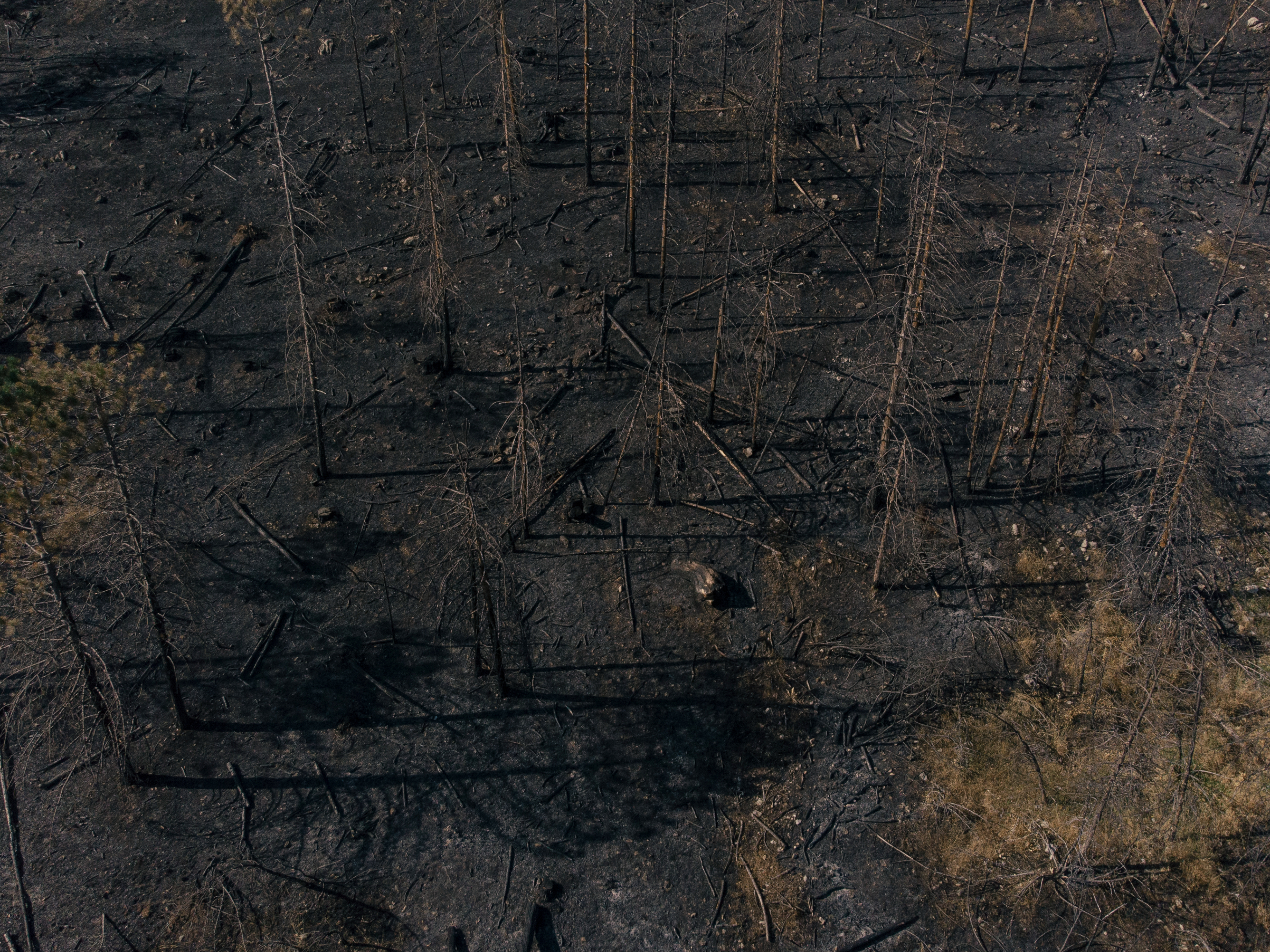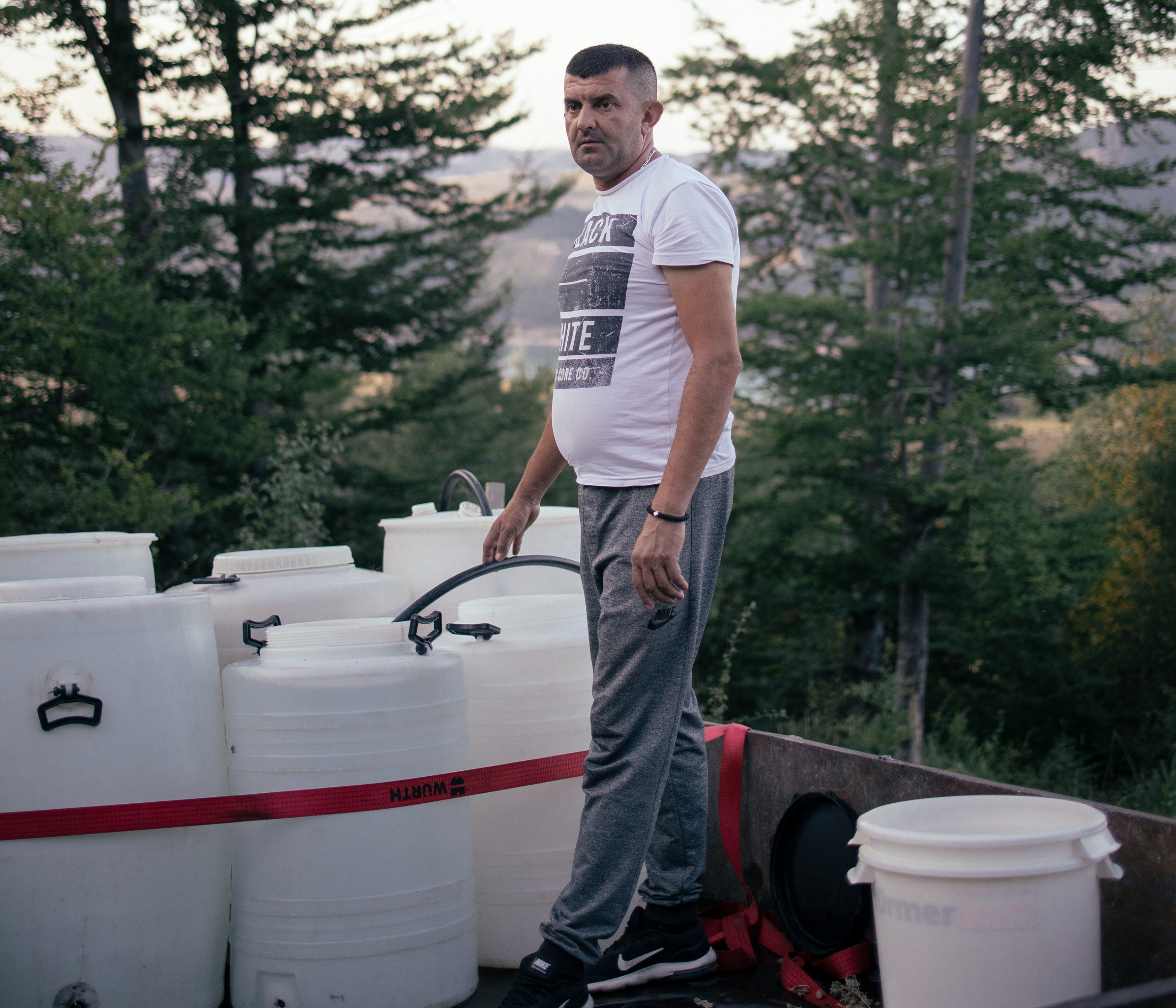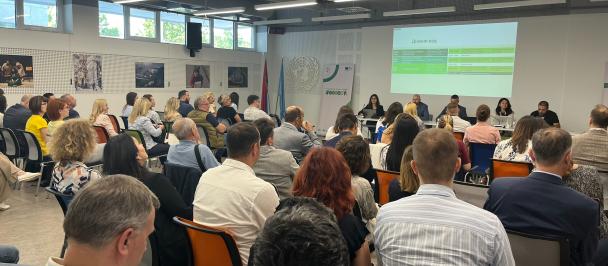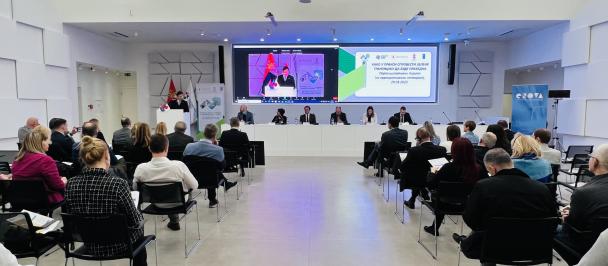The summer of 2021 was the 5th warmest summer in Serbia in the last 70 years, with a higher than average number of days having temperatures over 30 degrees. In certain parts of the country, the summer was both extremely warm and extremely dry.
In the Zlatibor region, for example, it was the fourth driest summer since 1950 and it brought a six-day heatwave to this part of Serbia in the second week of August.
The consequences of such weather were deeply felt by the people living in the villages scattered around the slopes of the Zlatibor region. Goran Ilić (59) from the village of Negbin nearly lost everything due to a forest fire, which started towards the end of July on the mountain of Murtenica and stopped some 100 metres from his house. Owing to the extremely high temperatures and inaccessible terrain it took 5 days to put out the fire. During that time, the fire destroyed 150 hectares of pine forest. One of these hectares belonged to Goran who lost his source of the firewood he sells and uses for heating his home. The fire also destroyed a field close to his house, about a hectare in size, which he used for grazing his sheep and cows. He says that the closest field now is on top of the mountain, some four kilometres away. The only choice for Goran was to take his cows to this other field and leave them there, since they would not survive a daily commute across such hilly terrain. He and his wife had to drive every day to the field to milk the cows as they needed the milk to make cheese and kajmak (a type of clotted cream cheese) the sale of which provides a part of their income. In spite of the irreversible damage the fire did to his property, Goran has no plans of leaving his land because, as he says, he has nowhere to go. And though the forest is irretrievably lost, he hopes the pastures will be washed clean by the rain and will recover.
Goran Ilić in a forest ravaged by fire.
Milorad Luković (50) from the village of Božetići on the mountain of Zlatar generates his income by selling milk and the renowned Zlatar cheese, a Serbian brand with a protected designation of origin. The dry summer left him and his neighbours, in around 550 households in nearby villages, without food and water for 6,000 dairy cows. Milorad says he does not remember the pastures, where the cows normally graze from May until the first snowfall, ever going completely dry. In order to feed his 15 cows, he had to purchase 7,500 kilograms of hay, which arrived from Sremska Mitrovica, some 320 kilometres away. Once drought sets in, the taps in Milorad’s house and in the majority of houses in the neighbouring villages remain dry. The water pipes bring water from nearby springs, which nowadays do not have sufficient quantities of water that could reach the households in the summer.
Delivery of hay on Milorad Luković's estate.
This is why Milorad is obliged to take his tractor every day to the small lake of Vrševina, where he and his neighbours pump water from the lake into their cisterns, which they then drive to their cows. In spite of all this effort, the milk yield dropped this year by one third which, together with the additional costs towards feed, left Milorad’s household in the red. They will have to resort to their stocks in order to survive the winter.
Besides his parents and his spouse, Milorad also has two daughters. They attend the local secondary school and university at the nearby town of Nova Varoš and Čačak respectively. Milorad cannot see them remaining in the country and hopes they will emigrate once they have completed their education.
The villagers of the nearby village of Bukovik also struggle with the same water shortage. Vojin Marinović, a resident of this village situated close to Nova Varoš, during periods of extreme draught, takes his cistern to the spring every other day to fill it up with 3 tons and 200 litres of technical water for his cattle. He also brings water from the spring to use at home.
His neighbour Sreten Paunović and his son Bojan also fill up their cisterns with technical water for the cattle, sometimes 3-4 times a day, while the other son Dejan goes to the source every day to fill up bottles at the spring so they can have drinking water at home. During the summer break Dejan walks 1 kilometre to the spring and back, and when he is not there to help, his grandfather is obliged to take over.
Stoja Ostojić (63) lives on her own in the village of Vraneša in the Zlatar region and takes care of two cows. She uses their milk to make cheese and kajmak which she sells to her customers in the neighbouring town of Nova Varoš. Her son Pero (39) lives there but comes to the village frequently, especially in the summer, when he takes his tractor every day to the local spring, some 2 kilometres away from his mother’s house, to bring back 1,000 litres of water for the household. His brother-in-law Željko helps and together they pour the water into the well, above the house, which they use as water storage.
At the same time, further to the north, in the region of Srem among the fertile Vojvodina plains, in the village of Belegiš, which lies on the banks of the Danube near the town of Stara Pazova, Milan Jovanović (41) and his brother Miloš work on the land they inherited from their father. They planted maize on their three hectares of land which they use to feed pigs and chickens on their nearby farm. They rely on the sun and warmth, which the maize stalks need in order to grow in the spring, and on the rain during the summer when kernels start growing on the cob. The weather failed them this year. The spring nights were fairly cold and, due to the lack of warmth and major differences between night and daytime temperatures, the maize stalks stagnated and, in July, when it was most needed, the rain did not come. Milan and Miloš estimate the maize yield this year will be 20% lower than expected, which means they will have to purchase additional feed for their pigs and poultry. Milan says that the future in maize farming lies in irrigation - a major investment, although it is difficult to calculate when it will start paying dividends.
Milan Jovanović, corn grower from Belegiš.
Only a couple of fields away, an investment is already paying dividends. In the middle of the golden fields of Belegiš lie 10 green hectares of arable land farmed by Nikola Lončar (41). This year, between May and September, he has managed to grow three different crops on the same piece of land: sweetcorn, cabbage and peppers, whose turn came in August. The fleshy red pepper yield was up by 30% due to the fact that Nikola’s farm has been “digitalised”.
The red pepper yield on the "̋digital" farm.
He purchased a climate-smart system from the “Mihajlo Pupin” Institute which uses remote sensors to measure the temperature, humidity and acidity of the soil. It also reads weather data from the wireless weather station on his farm, to calculate the quantity of liquid fertilizer and water for irrigating the field using a system of pipes. The system is supplied with sufficient quantities of water from a well that Nikola dug on his farm. Additionally, it uses energy from renewable sources such as the sun and the wind, which considerably reduces his electricity bill. It also saves a lot of time. This summer, while in Greece for a week, Nikola monitored his fields using a mobile phone application to observe data from the system and manage it remotely.
Nikola Lončar runs his farm from a mobile phone.
According to Aleksandar Rodić, a scientist from the “Mihajlo Pupin” Institute, the vast majority of agricultural farms in Serbia, as many as 95%, is made up of farms such as these two in the village of Belegiš with up to 10 hectares of arable land. He also says that only 2-3% out of 430,000 agricultural farms are currently being irrigated.
And what is the situation in the cities? About an hour’s drive from Belegiš, the residents of Belgrade enjoyed a vast selection of produce this summer, both from green markets and supermarkets. At the same time, they were quite unaware of what their suppliers in the countryside had to go through in order to produce this food. However, the high temperature also affected the people living in the capital - surrounded by concrete with few green spaces or while standing at bus stops. The summer of 2021 has been the warmest summer in Serbia’s capital since 1888. During 44 consecutive nights the temperature did not go below 25 and one June day set a new record for the last 100 years with a temperature of 38.7.
Zeleni venac in August.
In order to cool down, many residents of Belgrade resorted to city beaches, such as the Lido in Zemun and Ada Ciganlija. Even though it is situated only 4 kilometres away from the city centre, thanks to its forest, clearings and meadows, as well as being surrounded by water, Ada has its own microclimate and, therefore, due to its somewhat lower temperatures, the summer heat is more bearable there. Whenever they have time, Mladen Tomić and Rade Kovačević go to Ada to cool down. They tend to spend their free time there during the summer and swimming in the lake helps them imagine they are by the sea. The cool of Ada Ciganlija makes it an ideal place for the elderly residents of Belgrade where they spend time playing long games of chess, even with an outside city temperature of 38 degrees.
A game of chess in the deep shade of Ada Ciganlija.
Lido beach, Zemun.
Ypung people on Ada Ciganlija.
Even though people in Belgrade have places to escape to on very hot days, they still have to return to their homes around which there are neither enough trees nor space enough to plant them. In addition to providing shade, trees have yet another important role to play - purifying the city air. Microalgae do exactly that, but are from 10 to 50 times more efficient in “sucking up carbon dioxide” from the air than trees. Besides this, microalgae also suck up the noxious pollution particles from the air and are, therefore, even more efficient. To improve the air quality in city areas where there is not enough room to plant trees, the scientists from the Institute for Multidisciplinary Research of the University of Belgrade have come up with “liquid trees”, LIQUID 3, made up of an aquarium containing 600 litres of water with algae in it. LIQUID 3 “substitutes” two 10-year old trees or 200 square metres of lawn. The first “liquid tree” in Serbia was placed this summer in front of the Stari Grad city municipality building in Belgrade. Adjoining the tree is a smart bench powered by photovoltaic cells thereby providing passers-by with a chance to have a rest and recharge their mobile phones.
The ˝liquid tree˝ in front of Stari Grad city municipality building in Belgrade.
Dr Ivan Spasojevic, one of the authors of the project from the Institute for Multidisciplinary Research.
The weather conditions in Serbia will continue to change due to climate change and temperatures are expected to rise above the world average. If the global temperature average goes up by 1 degree, in Serbia it is expected to rise by 2 degrees.
This might not seem like much, but we have to bear in mind the fact that Serbia and the other states signatories to the Paris Climate Agreement have promised to keep the rise of average global temperature well below 2 compared to pre-industrial levels. If global temperatures continue to rise, extreme weather conditions such as wildfires, droughts and major floods will intensify and become ever more frequent and longer lasting.
The fire sparked by burning of stubble in the fields next to the highway near Belgrade.
Unsanitary dump near Požarevac.
The main cause behind climate change is human activity, namely the use of fossil fuels whose combustion produces emissions of greenhouse gasses (GHG). The increasing greenhouse effect and resulting planet overheating will cause the crops traditionally grown by Serbian farmers to produce lower yields and springs, which during certain parts of the year have sufficient water to reach higher altitude villages, to dry up during the summer. Because of the greenhouse effect, city dwellers feel like ‘fish out of water’ during the summer.
Wind park close to Alibunar.
To ensure long-term living conditions for people on this planet, including Serbia, we must stop heating up our green house, i.e. reduce GHG emissions, abandon fossil fuels and move on to renewable energy sources, such as the sun and the wind. Due to the fact that negative effects of climate change are already here, though all of us may not “see” them yet, we have to adapt in order to survive. And many smart solutions for our survival already exist. We just need to use them.
Zlatar lake, Kokin brod.
Uvac river next to Kokin brod settlement.
Author: Vladimir Živojinović/EastPic, summer 2021.

 Locations
Locations






